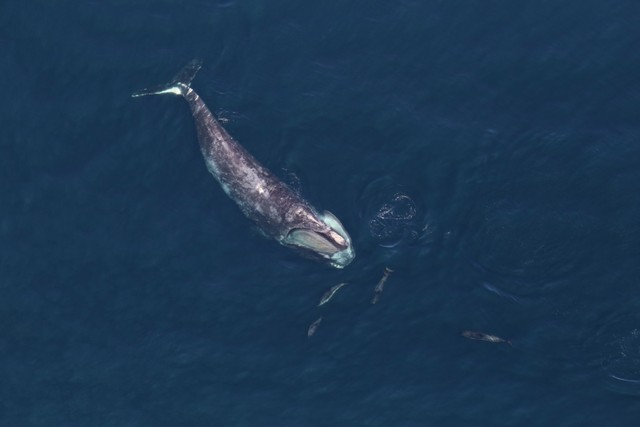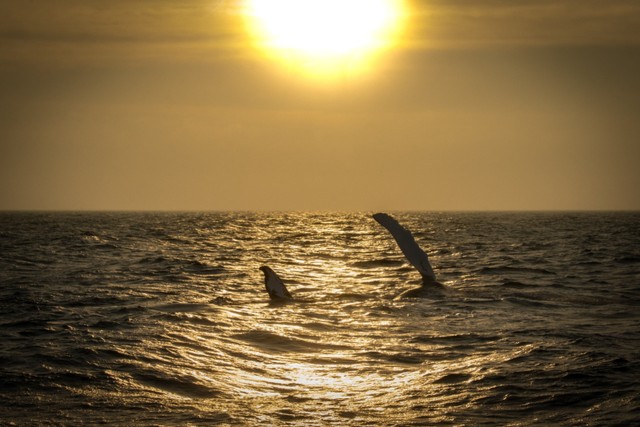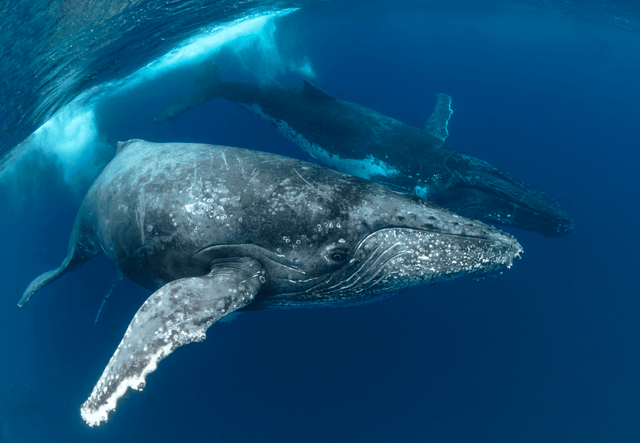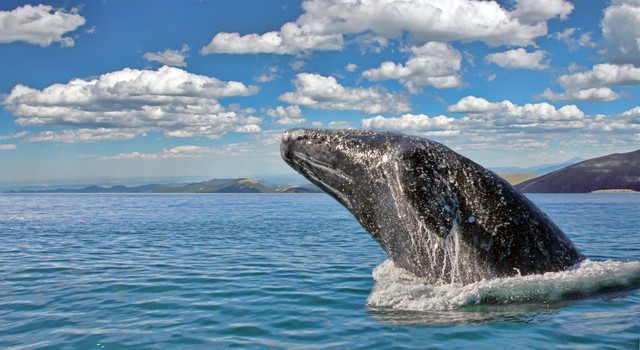Whale watching appeals to nature lovers and eco-conscious travelers, but as an activity that unavoidably disrupts the water, it also prompts important questions. Is whale watching ethical? What is the impact on whales? In a recent webinar hosted by City Experiences, naturalists from Atlantic and Pacific Coasts shared answers to those questions, while offering tips to ensure the net impact on whales remains positive. Use their advice below to protect whales in everyday life, then plan your next trip with our recommendations for responsible whale watching providers and eco-friendly lodging. (Recommendations our own.)
But first things first…
Is Whale Watching Ethical?
Naturalists concede that boat-led whale watches inevitably impact whales. But that doesn’t mean the impact is all negative. Done responsibly – with noise pollution kept at a minimum and distance regulations respected – the research and awareness generated are beneficial for whales, naturalists say.
“Whale watches engage and inspire people who would otherwise give whales little thought,” said Susan Emerson, naturalist for City Cruises San Diego. “If we can teach people about whales, then they may be inspired to get involved in conservation.”
Becoming invested in the protection of whales can also inspire behavioral change in other areas of life, including advocacy for protections against climate change, she added.
Laura Howes, a scientist with the Boston Aquarium and naturalist for Boston Harbor City Cruises, agrees. “The research we can do because of whale watches is an important part of understanding and protecting whales,” she said. “Without whale watching, we’d be lacking a lot of the data that is protecting local species.”
Choosing a Responsible Whale Watch Provider
The key to responsible whale watching is finding the right provider, Howes says, and asking the right questions can help. On the East Coast, companies can join WhaleSENSE to demonstrate their commitment to responsible practices. These include:
- Maintaining a minimum distance of 300 yards
- Refraining from feeding or engaging the whales
- Minimizing sound pollution by approaching and leaving whales slowly
- Giving whales some space
“You only want one to two boats in a 300-foot range,” says Howes. You can ensure that your own impact remains positive for whales by understanding if your provider chooses not to approach an overcrowded area. Use the guide below to find providers who actively work to protect whales.
Whale Watching in Boston
Thanks to the Stellwagen Bank National Marine Sanctuary, an 842-square-mile area of protected waters near the mouth of Massachusetts Bay, spotting a humpback whale is almost guaranteed from Boston. If you’re lucky, you might also catch a fin whale, minke whale, or even a North Atlantic Right Whale. Keen-eyed passengers might also catch spinner dolphins, or if it’s cool enough, Atlantic white-sided dolphins.
When to Go: Boston’s whale watching season runs from late April to October, although your best bet for whale sightings will be in the summer months.
Who to Use: Boston Harbor City Cruises, which has partnered with The New England Aquarium to offer responsible whale watch tours with whale experts like Laura Howes.
Where to Stay: The Seaport Boston. A member of the Green Hotels Association and Boston Green Tourism, the locally owned Seaport Hotel has long protected the environment, offering an in-room recycling program, a composting system, and a commitment to smart energy. Check out its Green Resume.
Whale Watching on Cape Cod
Cape Cod also benefits from Stellwagen Bank National Marine Sanctuary, although the whale species seen here can vary slightly from those in Boston. In addition to humpbacks, you might find the less common pilot and blue whales, or even one of the world’s roughly 500 remaining northern right whales, a critically endangered species that depends on the sanctuary’s conservation efforts.
When to Go: Late April to October
Who to Use: Hyannnis Whale Watcher Cruises. They use a boat specifically designed for whale watching, while following all responsible protocols. Like Boston Harbor City Cruises, Hyannis brings a naturalist for educational commentary.
Where to Stay: The Candleberry Inn, an independently run bed & breakfast in charming Brewster, 15 miles east of Hyannis and a short stroll from the beach. Listed in the National Registry of Historic Places, The Candleberry has a country cottage feel with some surprising amenities, including a guest pantry and complimentary self-serve ice cream. It even has its own guide to whale watching, which recommends options to see whales from the shore.
Whale Watching on Long Island
The Hamptons might not be known for whale watching, but the beaches of Long Island offer a wealth of natural treasures for those who venture beyond the shore. Beyond fin, minke, and humpback whales, naturalists off the coast of Montauk have reported seeing bottlenose and short-beaked common dolphins, sea turtles, multiple species of birds, and even hammerhead and mako sharks, making this “cool kid” enclave more than just a picturesque setting for celebrity weddings.
When to Go: July through Labor Day
Who to Use: Viking Fleet, which partners with The Coastal Research and Education Society of Long Island (CRESLI), a nonprofit organization that conducts research on whales and seals.
Where to Stay: Marram Montauk, a boutique hotel within walking distance of Shadmoor State Park where guests can unplug with complimentary cruiser bikes, nature walks, and creative workshops. Guests have even been known to spot whales from the oceanfront pool.
Whale Watching in San Diego
Off the sunny coast of San Diego, you’ll find fin, minke and humpback whales year-round, as well as gray and blue whales, depending on the season. On the right day, you might also spot bottlenose, risso, Pacific white-sided dolphins or even sea lions.
When to Go: California has two main seasons: the summer season, which runs from late June to late August, and the winter season, which runs from mid-December through April. In the winter season, California becomes the “marine highway” for gray whales migrating to the Arctic from Baja, bringing them incredibly close to the shore. In the summer season, you can see blue whales and fin whales, found in deeper waters.
Who to Use: City Cruises San Diego, which offers professionally narrated cruises with naturalists like Susan Emerson, and goes above and beyond to operate with minimal impact on whales, including using yacht stabilizers to minimize motion in the water. You’re also guaranteed a sighting – if you don’t spot a whale on your tour, you’ll receive a pass to return for a future cruise.
Where to Stay: The Green Room Hotel, a charming, 12-suite hotel in the under-the-radar Oceanside neighborhood about 40 minutes north of San Diego. This bohemian throwback to mid-century surf culture has complimentary foam surf boards and cruiser bikes to borrow, a communal fire pit, and a cedar hot tub.
Whale Watching in San Francisco
With a prime location along the Pacific migration “highway”, San Francisco is (briefly) home to many whale species. In the lengthy summer season, which runs through November, you can catch humpbacks and blue whales. Just a month later, gray whales, sperm whales and even Orcas start to appear. Depending on the season, you may also spot dolphins, porpoises, sea lions and harbor seals.
When to Go: San Francisco follows San Diego with a fairly long season from May to November, and a winter season from December to May.
Who to Use: Take a trip with the Oceanic Society to support whale research and conservation efforts for many other animals, including dolphins and sea turtles. The naturalist-led Oceanic Society tours also provide an opportunity to see rare species, such as the leucistic white orca seen on a recent trip. Check out the site for more information.
Where to Stay: The Argonaut Hotel, a certified Green Business and fixture of the Bay Area. Known for its energy conservation, the four-diamond hotel has swapped tiny toiletries for more economically sized bottles, recycles its kitchen grease into biofuel, and sources food locally for its on-site restaurant, The Blue Mermaid. The Argonaut also has complimentary cruiser bikes, old-school board games, and a courtyard with a communal fire pit.
Whale Watching Worldwide
With whale watching available from Alaska to Australia, your whale watching bucket list could be longer than the species available to view. Wherever you go, be sure to educate yourself about whale species, habits and best practices before choosing a provider. Ask the right questions, and you’ll remain part of a positive force that protects these gentle giants, rather than a hindrance that further disrupts their environment.






